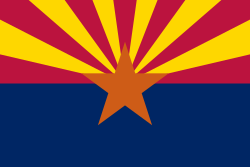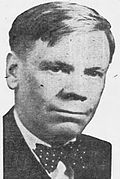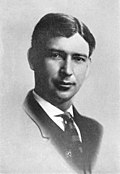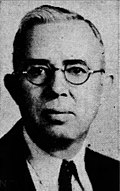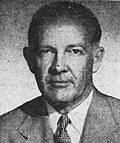Top Qs
Timeline
Chat
Perspective
List of governors of Arizona
From Wikipedia, the free encyclopedia
Remove ads
The governor of Arizona is the head of government of the U.S. state of Arizona.[5] As the top elected official, the governor is the head of the executive branch of the Arizona state government and is charged with faithfully executing state laws.[5] The governor has the power to either approve or veto bills passed by the Arizona State Legislature;[6] to convene the legislature;[5] and to grant pardons,[7] with the exception of cases of impeachment. The governor is also the commander-in-chief of the state's military forces.[8] Arizona is one of the few states that currently does not have a governor's mansion or other official residence.
Twenty-four people have served as governor over 28 distinct terms. All of the repeat governors were in the state's earliest years, when George W. P. Hunt and Thomas Edward Campbell alternated as governor for 17 years and, after a two-year gap, Hunt served another term. One governor, Evan Mecham, was impeached by the Arizona House of Representatives and subsequently removed from office following his conviction in the Arizona Senate. Another, Fife Symington, resigned upon being convicted of a felony. The longest-serving governor was Hunt, who was elected seven times and served just under fourteen years. The longest single stint was that of Bruce Babbitt, who was elected to two four-year terms after succeeding to the office following the death of his predecessor, Wesley Bolin, serving nearly nine years total. Bolin had the shortest tenure, dying less than five months after succeeding as governor. Arizona has had five female governors, the most in the United States, and was the first—and until 2019 (when Michelle Lujan Grisham succeeded Susana Martinez in neighboring New Mexico) the only—state where female governors served consecutively.
The current governor as of January 2, 2023, is Democrat Katie Hobbs.
Remove ads
List of governors
Summarize
Perspective
Confederate Arizona
In Tucson between April 2 and April 5, 1860, a convention of settlers from the southern half of New Mexico Territory drafted a provisional constitution for "Arizona Territory", three years before the United States would create such a territory. This proposed territory consisted of the part of New Mexico Territory south of 33° 40' north. On April 2,[9] they elected a governor, Lewis S. Owings. The provisional territory was to exist until such time as an official territory was created, but that proposal was rejected by Congress at the time.[10]
On March 16, 1861, soon before the American Civil War broke out, a convention in Mesilla voted that the provisional territory should secede from the Union and join the Confederacy.[11] Lewis S. Owings remained on as the provisional governor of the territory.
The Confederacy took ownership of the territory on August 1, 1861, when forces led by Lieutenant Colonel John R. Baylor won decisive control of the territory, and Baylor proclaimed himself governor.[12] Arizona Territory was formally organized in the Confederacy on January 18, 1862.[13] On March 20, 1862, Baylor issued an order to kill all the adult Apache and take their children into slavery.[12] When Confederate President Jefferson Davis learned of this order, he strongly disapproved and demanded an explanation. Baylor wrote a letter December 29, 1862, to justify his decision, and after this was received, Davis relieved Baylor of his post and commission, calling his letter an "avowal of an infamous crime". By that time, the Confederate government of Arizona Territory was in exile in San Antonio, Texas, as the territory had been effectively lost to Union forces in July 1862;[14] no new governor was appointed.
Territory of Arizona
Arizona Territory was formed on February 24, 1863, from New Mexico Territory, remaining a territory for 49 years.[15]
State of Arizona
The state of Arizona was admitted to the Union on February 14, 1912, the last of the contiguous states to be admitted.
The state constitution of 1912 called for the election of a governor every two years.[124] The term was increased to four years by a 1968 amendment.[125][126] The constitution originally included no term limit,[127] but an amendment passed in 1992 allows governors to succeed themselves only once;[124] before this, four governors were elected more than twice in a row. Gubernatorial terms begin on the first Monday in the January following the election.[124] Governors who have served the two term limit can run again after four years out of office.
Arizona is one of the few states which does not have a lieutenant governor. Instead, in the event of a vacancy in the office of governor, the secretary of state, if elected, succeeds to the office. If the secretary of state was appointed rather than elected, or is otherwise ineligible to hold the office of governor, the next elected and eligible person in the line of succession assumes the office. The state constitution specifies the line of succession to be the Secretary of State, Attorney General, State Treasurer and Superintendent of Public Instruction, in that order.[128] If the governor is out of the state or impeached, the next elected officer in the line of succession becomes acting governor until the governor returns or is cleared.[128] In either case, any partial term counts toward the limit of two consecutive terms.
The line of succession has reached beyond the secretary of state only once, when Attorney General Bruce Babbitt became governor upon the death of Wesley Bolin. Rose Mofford had been appointed secretary of state to replace Bolin after Bolin succeeded to the governorship. Bolin had become governor when Raúl Héctor Castro resigned to accept appointment as ambassador to Argentina. Mofford later became acting governor after Evan Mecham was impeached by the House of Representatives, and succeeded to the governorship when Mecham was removed from office after his conviction by the Senate.
Starting with the 2026 election cycle, Arizona will have a lieutenant governor, pursuant to a 2022 amendment to the constitution.[129] Nominees will be chosen by each party's gubernatorial nominee, with the governor and lieutenant governor then chosen by general election voters on a joint ticket.[129] If the offices of governor and the lieutenant governor become vacant at the same time, the amended law provisions of the state constitution are that the secretary of state, attorney general, state treasurer or the superintendent of public instruction will assume the office of governor and then appoint the lieutenant governor pending state legislative approval.[130]
Remove ads
Timeline
| Timeline of Arizona governors |
 |
See also
Notes
- The range given is from the date the governor was confirmed by the Senate, or appointed by the President during a Senate recess, to the date the governor's successor was confirmed, unless noted.
- Goodwin resigned, having been elected to the United States House of Representatives for a term which began on March 4, 1865; he held both offices for thirteen months.[20]>[26]
- Hoyt was appointed on April 5, 1877,[42] during a Senate recess; nominated on October 17,[40] and confirmed by the Senate on October 29.[43] Despite already being in the territory when appointed, he did not take office until May 30, due to involvement as secretary of the territory in litigation over moving the territorial capital.[41][44]
- Tritle resigned after Grover Cleveland was elected president, so that the Democrat could appoint a Democrat as governor.[51][56]
- His successor having been sworn in out of state, and given instruction from the federal government, Franklin resigned the office and handed over duties to the secretary of the territory, Charles H. Akers.[91]
- McCord resigned to serve in the Spanish–American War.[92][97]
- Murphy was asked by President Theodore Roosevelt to resign for opposing the Newlands Reclamation Act;[103] he submitted his resignation in April 1902 to take effect June 30,[104] and remained until his successor took office.[105]
- Brodie resigned, having been appointed assistant chief of the records and pension bureau at the United States Department of War.[110][111]
- Initial results showed that Campbell had won by 30 votes, but Hunt challenged the results, claiming that several precincts had experienced fraudulent voting.[138] The Arizona Supreme Court named Campbell governor on January 27, 1917, and forced Hunt to surrender his office.[139] Hunt continued fighting in court, and on December 22, was declared the winner of the election by 43 votes.[140] Campbell vacated the office three days later.[133]
- Garvey lost the Democratic nomination to Ana Frohmiller.[162][165]
- Castro resigned, having been confirmed as United States Ambassador to Argentina.[182]
- Symington resigned after being convicted of bank fraud; the conviction was later overturned and he was pardoned by President Bill Clinton.[195][197]
- Napolitano resigned, having been confirmed as United States Secretary of Homeland Security.[202]
- Hobbs' term will expire on January 4, 2027. She is running for reelection.
Remove ads
References
External links
Wikiwand - on
Seamless Wikipedia browsing. On steroids.
Remove ads


